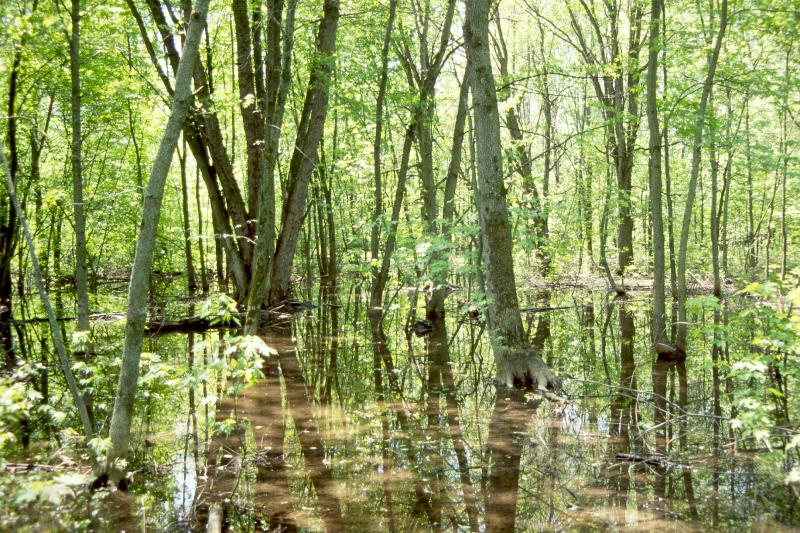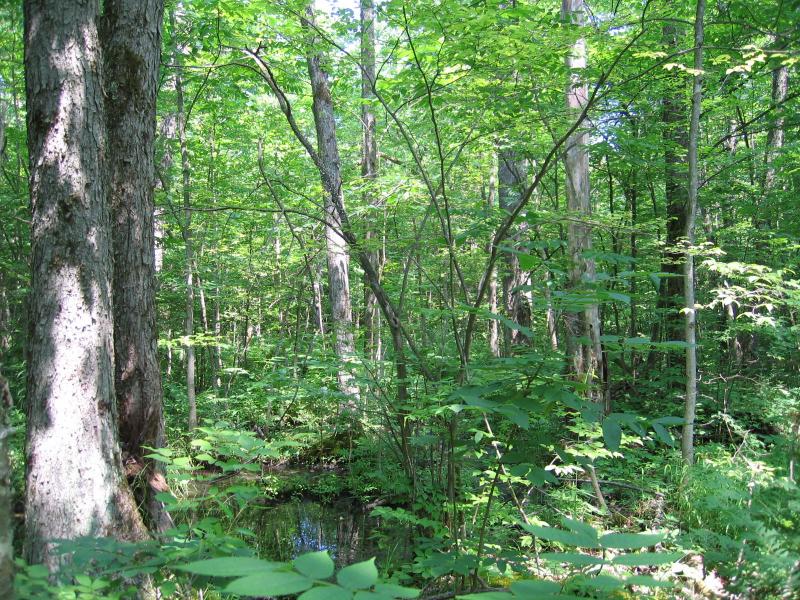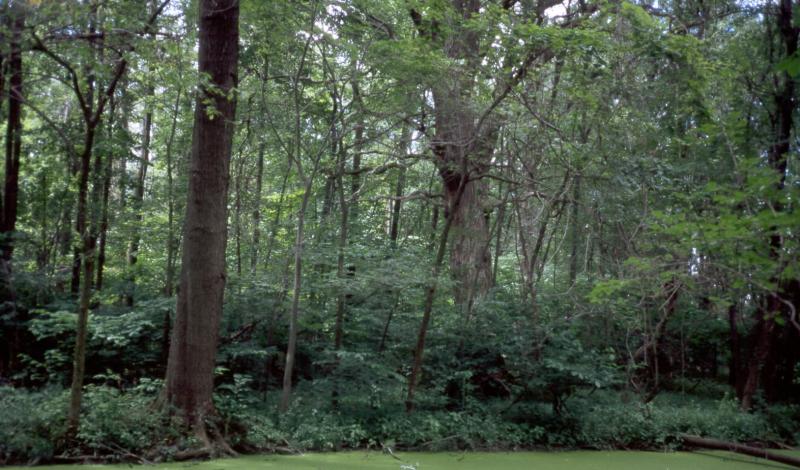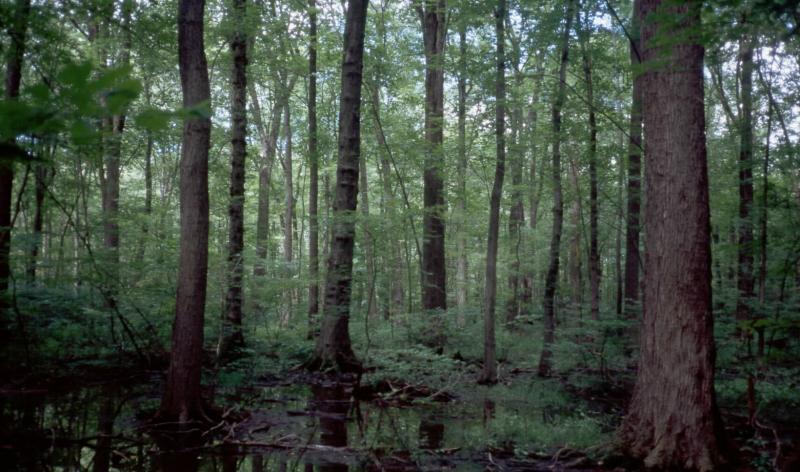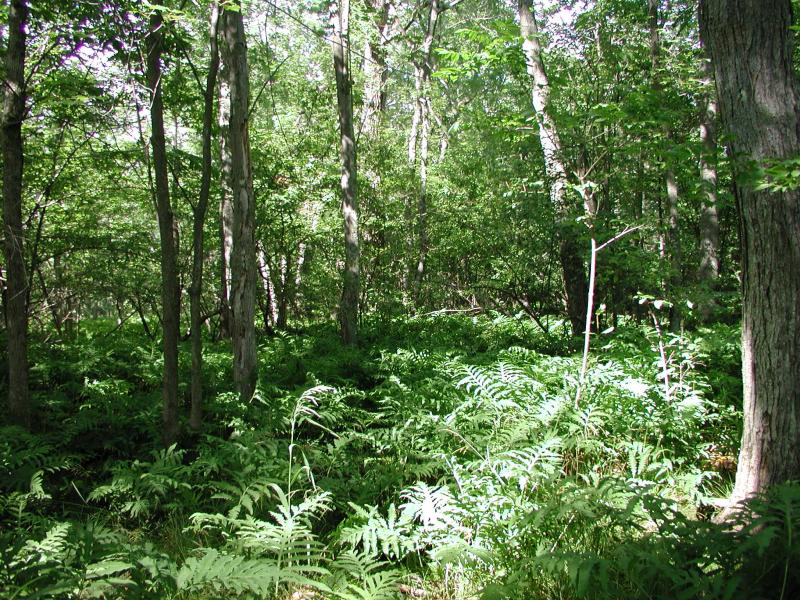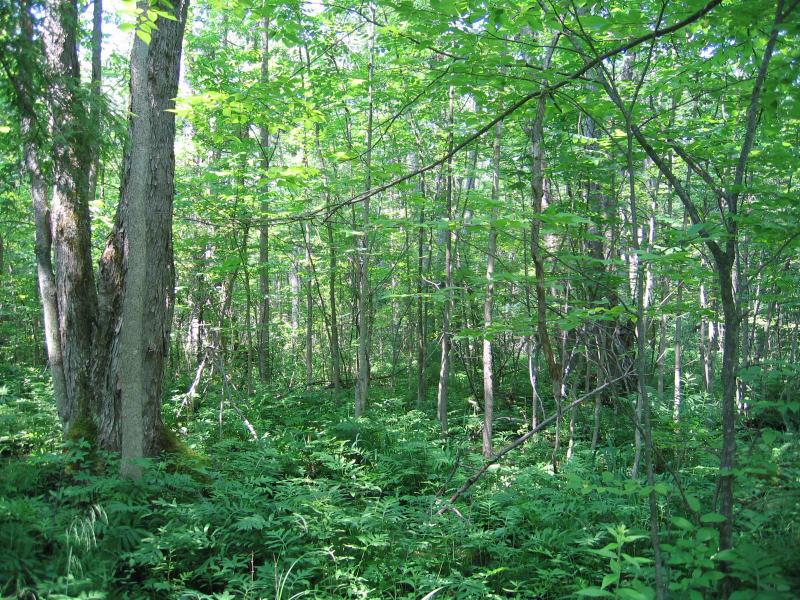Silver Maple-Ash Swamp
- System
- Palustrine
- Subsystem
- Forested Mineral Soil Wetlands
- State Protection
- Not Listed
Not listed or protected by New York State.
- Federal Protection
- Not Listed
- State Conservation Status Rank
- S3
Vulnerable in New York - Vulnerable to disappearing from New York due to rarity or other factors (but not currently imperiled); typically 21 to 80 populations or locations in New York, few individuals, restricted range, few remaining acres (or miles of stream), and/or recent and widespread declines.
- Global Conservation Status Rank
- G4
Apparently Secure globally - Uncommon in the world but not rare; usually widespread, but may be rare in some parts of its range; possibly some cause for long-term concern due to declines or other factors.
Summary
Did you know?
The naturally occurring hybrid between silver maple (Acer saccharinum) and red maple (Acer rubrum) is the Freeman's Maple (Acer x freemanii). The leaf lobes of the hybrid are intermediate in length compared to its parents. Freeman's Maple is commonly found in silver maple-ash swamps in the counties along the Lake Ontario shore.
State Ranking Justification
There are about a thousand occurrences statewide. Some of the documented occurrences have good viability and many are protected on public land or private conservation land. This community is limited in distribution to the central and western parts of the state, and includes a few large, high quality examples. The current trend of this community is probably stable for occurrences on public land, or declining slightly elsewhere due to moderate threats that include alteration of the natural hydrology and invasive species.
Short-term Trends
The number and acreage of silver maple-ash swamps in New York have probably declined slightly, or have remained stable, in recent decades as a result of wetland protection regulations.
Long-term Trends
The number and acreage of silver maple-ash swamps in New York have probably declined substantially from historical numbers, likely correlated with agricultural and other development. Several occurrences were likely converted to open wetland types, such as shallow and deep emergent marsh, by flooding.
Conservation and Management
Threats
Silver maple-ash swamps are threatened by development (e.g., agriculture, residential, roads, powerline ROWs) and its associated run-off (e.g., septic, silt, nutrients), habitat alteration (e.g., excessive logging, pollution, trash dumping), and recreational overuse (e.g., trails, golf course run-off). Alteration to the natural hydrological regime is also a threat to this community (e.g., ditching, impoundments, blocked culverts, beaver). Over-browsing by deer threatens the herb layer and tree seedling regeneration at a couple sites. Several silver maple-ash swamps are threatened by invasive species, such as purple loosestrife (Lythrum salicaria), reedgrass (Phragmites australis ssp. australis), garlic mustard (Alliaria petiolaris), common buckthorn (Rhamnus cathartica), shrubby honeysuckle (Lonicera tartarica), and multiflora rose (Rosa multiflora). Conversion of wetlands for agriculture was a major cause of inland wetland loss in many areas of the Northeast historically, and it is still an important factor today, most notably in New York (Golet et al. 1993). The emerald ash borer (Agrilus planipennis) is an Asian beetle that infests and kills North American ash trees. All native ash trees are susceptible, including white ash, green ash, and black ash. In New York, emerald ash borer has been found mostly south of the Adirondack Mountains, but in 2017 it was recorded in Franklin and St. Lawrence Counties. Natural communities dominated or co-dominated by ash trees would likely be most impacted by emerald ash borer invasion.
Conservation Strategies and Management Practices
Where practical, establish and maintain a natural wetland buffer to reduce storm-water, pollution, and nutrient run-off, while simultaneously capturing sediments before they reach the wetland. Buffer width should take into account the erodibility of the surrounding soils, slope steepness, and current land use. Wetlands protected under Article 24 are known as New York State "regulated" wetlands. The regulated area includes the wetlands themselves, as well as a protective buffer or "adjacent area" extending 100 feet landward of the wetland boundary (NYS DEC 1995). If possible, minimize the number and size of impervious surfaces in the surrounding landscape. Avoid habitat alteration within the wetland and surrounding landscape. For example, roads and trails should be routed around wetlands, and they should ideally not pass through the buffer area. If the wetland must be crossed, then bridges and boardwalks are preferred over filling. Restore silver maple-ash swamps affected by unnatural disturbance (e.g., remove obsolete impoundments and ditches in order to restore the natural hydrology). Prevent the spread of invasive exotic species into the wetland through appropriate direct management, and by minimizing potential dispersal corridors, such as roads.
Development and Mitigation Considerations
When considering road construction and other development activities minimize actions that will change what water carries and how water travels to this community, both on the surface and underground. Water traveling over-the-ground as run-off usually carries an abundance of silt, clay, and other particulates during (and often after) a construction project. While still suspended in the water, these particulates make it difficult for aquatic animals to find food; after settling to the bottom of the wetland, these particulates bury small plants and animals and alter the natural functions of the community in many other ways. Thus, road construction and development activities near this community type should strive to minimize particulate-laden run-off into this community. Water traveling on the ground or seeping through the ground also carries dissolved minerals and chemicals. Road salt, for example, is becoming an increasing problem both to natural communities and as a contaminant in household wells. Fertilizers, detergents, and other chemicals that increase the nutrient levels in wetlands cause algae blooms and eventually an oxygen-depleted environment where few animals can live. Herbicides and pesticides often travel far from where they are applied and have lasting effects on the quality of the natural community. So, road construction and other development activities should strive to consider: 1. how water moves through the ground, 2. the types of dissolved substances these development activities may release, and 3. how to minimize the potential for these dissolved substances to reach this natural community.
Inventory Needs
Survey for occurrences statewide to advance documentation and classification of silver maple-ash swamps. A statewide review of silver maple-ash swamps is desirable. Continue searching for large sites in good condition (A- to AB-ranked).
Research Needs
Research the composition of silver maple-ash swamps statewide in order to clearly separate this community from silver maple-dominated floodplain forests. Collect sufficient plot data to support the recognition of an ash-dominated swamp with no silver maple as a potentially new community type.
Rare Species
- Agrimonia rostellata (Woodland Agrimony) (guide)
- Ardea herodias (Great Blue Heron) (guide)
- Asimina triloba (Pawpaw) (guide)
- Carex lupuliformis (False Hop Sedge) (guide)
- Carex typhina (Cat-tail Sedge) (guide)
- Carya laciniosa (Big Shellbark Hickory) (guide)
- Geum virginianum (Cream-colored Avens) (guide)
- Lysimachia hybrida (Lowland Loosestrife) (guide)
- Macropis nuda (Common Loosestrife Oil Bee) (guide)
- Melanerpes erythrocephalus (Red-headed Woodpecker) (guide)
- Protonotaria citrea (Prothonotary Warbler) (guide)
- Quercus shumardii var. shumardii (Shumard Oak) (guide)
- Setophaga cerulea (Cerulean Warbler) (guide)
Range
New York State Distribution
This community is primarily limited to the lowlands of central and western New York. It is concentrated in the Great Lakes and High Allegheny Plateau Ecoregions, including the Saint Lawrence Lowlands, especially the southwest portion, and the Lake Champlain Lowlands, especially the northern portion where it approaches large patch size. It is essentially absent from the Northern Appalachians Ecoregion. It is suspected to be peripheral and very uncommon in the Lower New England Ecoregion, and probably only at the northern portion of the ecoregion in Columbia County and northward.
Global Distribution
This community is suspected to be widespread throughout the lowlands of the Great Lakes and the High Allegheny Plateau. This range is estimated to span north to Ontario, west to Wisconsin, south to Tennessee and West Virginia, and east to Vermont.
Best Places to See
- Valcour Island Primitive Area, Adirondack Park
- Great Baehre Swamp Wildlife Management Area
- Catharine Creek Wildlife Management Area (Schuyler County)
- Lake Shore Marshes Wildlife Management Area (Wayne County)
- Conewango Swamp Wildlife Management Area
- Wilson Hill Wildlife Management Area (St. Lawrence County)
- Conesus Inlet Fish And Wildlife Management Area (Livingston County)
- Joralemon Town Park
- Adirondack Park
- Three Mile Bay Wildlife Management Area (Oswego County)
- Bergen Swamp Preserve
Identification Comments
General Description
Silver maple-ash swamps are hardwood basin swamps that occur in poorly-drained depressions or on poorly-drained soils along the borders of large lakes or, less frequently, rivers. The sites are characterized by uniformly wet conditions, with minimal seasonal fluctuation in water levels. The tree canopy is dominated by silver maple (Acer saccharinum) and green ash (Fraxinus pennsylvanica), but typically includes a variety of other hardwood species such as American elm (Ulmus americana), red maple (Acer rubrum), swamp white oak (Quercus bicolor), and ironwood (Carpinus caroliniana). This community has a well-developed understory of tall shrub, short shrub, and herbaceous species. Silver maple-ash swamps often occur over calcareous bedrock, and the plant species composition may reflect this influence with the presence of calciphiles such as northern white cedar (Thuja occidentalis) and alder-leaf buckthorn (Rhamnus alnifolia) (Edinger et al. 2002).
Characters Most Useful for Identification
A closed-canopy hardwood swamp within a basin, with a canopy dominated by silver maple and green ash. A diverse suite of canopy, shrub, and herbaceous species are also associated with this community.
Elevation Range
Known examples of this community have been found at elevations between 95 feet and 1,310 feet.
Best Time to See
During the summer, silver maple-ash communities are lush with vegetation, including ferns, tall shrubs, and a large variety of herbaceous species. Beautiful blueflag iris (Iris versicolor) blooms early in the summer, and eye-catching spotted jewelweed (Impatiens capensis) blooms mid to late summer. During the fall, this community becomes very scenic as the canopy species change color.
Silver Maple-Ash Swamp Images
Classification
International Vegetation Classification Associations
This New York natural community encompasses all or part of the concept of the following International Vegetation Classification (IVC) natural community associations. These are often described at finer resolution than New York's natural communities. The IVC is developed and maintained by NatureServe.
- (Red Maple, Silver Maple) - Ash species - American Elm Swamp Forest (CEGL005038)
NatureServe Ecological Systems
This New York natural community falls into the following ecological system(s). Ecological systems are often described at a coarser resolution than New York's natural communities and tend to represent clusters of associations found in similar environments. The ecological systems project is developed and maintained by NatureServe.
- North-Central Interior and Appalachian Rich Swamp (CES202.605)
Characteristic Species
-
Trees > 5m
- Acer rubrum var. rubrum (common red maple)
- Acer saccharinum (silver maple)
- Acer x freemanii
- Fraxinus americana (white ash)
- Fraxinus nigra (black ash)
- Fraxinus pennsylvanica (green ash)
- Quercus bicolor (swamp white oak)
- Ulmus americana (American elm)
- Ulmus rubra (slippery elm)
-
Shrubs 2 - 5m
- Alnus incana ssp. rugosa (speckled alder)
- Carpinus caroliniana ssp. virginiana (musclewood, ironwood, American hornbeam)
- Cornus amomum ssp. amomum (silky dogwood)
- Cornus racemosa (gray dogwood, red-panicled dogwood)
- Ilex verticillata (common winterberry)
- Lindera benzoin (spicebush)
- Viburnum lentago (nannyberry)
-
Shrubs < 2m
- Ilex verticillata (common winterberry)
-
Vines
- Parthenocissus quinquefolia (Virginia-creeper)
- Toxicodendron radicans ssp. radicans (eastern poison-ivy)
-
Herbs
- Bidens cernua (nodding beggar-ticks)
- Bidens frondosa (devil's beggar-ticks)
- Boehmeria cylindrica (false nettle)
- Carex crinita var. crinita (common fringed sedge)
- Carex lupulina (hop sedge)
- Glyceria striata (fowl manna grass)
- Impatiens capensis (spotted jewelweed, spotted touch-me-not)
- Iris versicolor (blue flag)
- Laportea canadensis (wood-nettle)
- Lysimachia nummularia (moneywort, creeping-Jenny)
- Matteuccia struthiopteris var. pensylvanica (ostrich fern)
- Onoclea sensibilis (sensitive fern)
- Osmunda regalis var. spectabilis (royal fern)
- Osmundastrum cinnamomeum var. cinnamomeum (cinnamon fern)
- Symplocarpus foetidus (skunk-cabbage)
- Thelypteris palustris var. pubescens (marsh fern)
Similar Ecological Communities
- Floodplain forest
(guide)
Floodplain forests are situated on mineral soils on low terraces of river floodplains and river deltas, and are characterized by their flooding regime: low areas are annually flooded in spring and high areas are flooded irregularly. Silver maple-ash swamps are contained within basins and are characterized by uniformly wet conditions with minimal seasonal fluctuation in water levels.
- Red maple-blackgum swamp
(guide)
Red maple-blackgum swamps have a canopy that is codominated by blackgum (Nyssa sylvatica) and red maple; silver maple is scarce or absent.
- Red maple-hardwood swamp
(guide)
Red maple-hardwood swamps are dominated by red maple; silver maple is generally absent.
- Red maple-sweetgum swamp
(guide)
Red maple-sweetgum swamps have a canopy that is codominated by sweetgum (Liquidambar styraciflua) and red maple; silver maple is scarce or absent.
Vegetation
Percent cover
This figure helps visualize the structure and "look" or "feel" of a typical Silver Maple-Ash Swamp. Each bar represents the amount of "coverage" for all the species growing at that height. Because layers overlap (shrubs may grow under trees, for example), the shaded regions can add up to more than 100%.
Additional Resources
References
Cowardin, L.M., V. Carter, F.C. Golet, and E.T. La Roe. 1979. Classification of wetlands and deepwater habitats of the United States. U.S. Fish and Wildlife Service. Washington, D.C. 131 pp.
Edinger, G. J., D. J. Evans, S. Gebauer, T. G. Howard, D. M. Hunt, and A. M. Olivero (editors). 2014. Ecological Communities of New York State. Second Edition. A revised and expanded edition of Carol Reschke’s Ecological Communities of New York State. New York Natural Heritage Program, New York State Department of Environmental Conservation, Albany, NY. https://www.nynhp.org/ecological-communities/
Edinger, Gregory J., D.J. Evans, Shane Gebauer, Timothy G. Howard, David M. Hunt, and Adele M. Olivero (editors). 2002. Ecological Communities of New York State. Second Edition. A revised and expanded edition of Carol Reschke's Ecological Communities of New York State. (Draft for review). New York Natural Heritage Program, New York State Department of Environmental Conservation. Albany, NY. 136 pp.
Huenneke, Laura Foster. 1982. Wetland forests of Tompkins County, New York. Bulletin Torrey Botanical Club. 109:51-63.
New York Natural Heritage Program. 2024. New York Natural Heritage Program Databases. Albany, NY.
New York State Department of Environmental Conservation. 1995. Freshwater Wetlands: Delineation Manual. July 1995. New York State Department of Environmental Conservation. Division of Fish, Wildlife, and Marine Resources. Bureau of Habitat. Albany, NY.
Reschke, Carol. 1990. Ecological communities of New York State. New York Natural Heritage Program, New York State Department of Environmental Conservation. Latham, NY. 96 pp. plus xi.
Links
About This Guide
This guide was authored by: Aissa Feldmann
Information for this guide was last updated on: November 13, 2023
Please cite this page as:
New York Natural Heritage Program. 2024.
Online Conservation Guide for
Silver maple-ash swamp.
Available from: https://guides.nynhp.org/silver-maple-ash-swamp/.
Accessed July 27, 2024.
